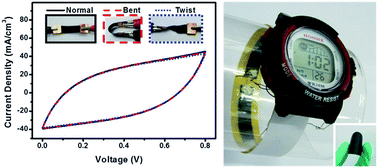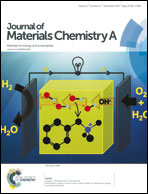Flexible supercapacitors based on carbon nanotube/MnO2 nanotube hybrid porous films for wearable electronic devices†
Abstract
To meet the requirement of clean and efficient energy storage system for practical applications, supercapacitors (SCs) to be promising candidates for the next-generation energy storage devices have received tremendous attentions. In fact, the SCs can have broader potential if they are designed as flexible power supplies for wearable electronic devices. Herein, we develop the first flexible, low-cost and high-performance hybrid electrode based on MnO2 nanotubes (NTs) and carbon nanotubes (CNTs) by employing a facile vacuum-filtering method. The superior mechanical and electrochemical performance of these flexible electrodes is attributed to: (1) the ultra-long one-dimensional nanotube morphology, (2) the synergistic effects between pseudocapacitive MnO2 NTs and conductive CNTs, (3) hierarchical porous structure of the freestanding film, and (4) high mass loading of MnO2 (4 mg cm−2). Subsequently, the as-synthesized freestanding CNT/MnO2 NT hybrid electrodes are assembled in the form of solid-state SC devices using polyvinyl alcohol (PVA)/LiCl as gel electrolyte. The device exhibits an excellent volumetric capacitance of 5.1 F cm−3 and a high energy density of 0.45 mW h cm−3 for the entire SC volume. Finally, these SCs are integrated in a flexible power band that can drive watches and LEDs. The solid-state SC devices with outstanding flexibility and stability clearly demonstrate their broad applications as flexible, low-cost, high-performance power supplies in wearable electronic devices.


 Please wait while we load your content...
Please wait while we load your content...